Entries tagged with “respirator”.
Did you find what you wanted?
Wed 2 Jan 2013
Posted by admin under Biological Monitoring, fit testing, Management, OSHA, Respirators, Safety Policies, Safety Programs, Training
Comments Off on Medical Questionnaire for respirators – a tip
Before you can wear a respirator here’s what has to happen:
If you’re an employer and your employees wear a respirator, they are required to have a medical approval (Appendix C of OSHA respiratory standard). more details here.
The employee fills out the confidential questionnaire and then submits it to the medical provider of the employer’s choice. 95% (I made that # up) of the time, based upon the questionnaire ONLY, they give an approval to wear a respirator.
Occasionally, some employees are requested to come into the medical office to have a spirometry test performed, which tests for lung function. (a video of how it is done, cool accent included) This tests provides more information for the physician/nurse to determine if wearing a respirator will be too difficult for an employee to wear.
The cost for either test is usually pretty close to the same price… spirometry test, or not.
Here’s my suggestion:  Have every employee perform a spirometry test before wearing a respirator. This helps to guarantee they are capable of wearing a respirator. Maybe they forgot to list a risk factor, maybe they have a hidden serious lung problem, or, maybe they lied on the questionnaire so they can wear a respirator and keep their job.?
It is also beneficial for pre-employment screening, claims defense, and for a baseline in health. The specific results are usually NOT view-able by the employer, but they can be subpoenaed.
Mon 16 Jul 2012
Posted by admin under fit testing, Respirators, Safety Programs, Training
Comments Off on Fit Testing – tips and suggestions
There are two types of fit testing, 1. quantitative and, 2. qualitative. For quantitative fit testing you’ll need a machine (ex. Portacount), Â a respirator that will protect more than 50x the limits (>full face). Â I will not cover this type of fit testing in this post, but it is very similar.
For qualitative fit testing you will need:
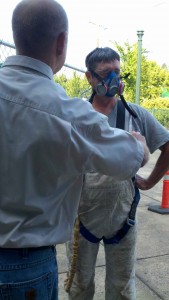
A medical clearance (not needed if you are wearing a paper dust mask) for each employee wearing a respirator.
Respirator w/P-100 filters (1/2 face respirator or more protective), aka HEPA filters, purple in color.
fit test kit -your choices are: saccharine, irritant smoke, Bitrex, or isoamyl acetate-bananas. Buy it online, or at your local safety supplier. Look at their instructions.
My preference is to use irritant smoke. The reasons are;
- Â if they cough, it means they smelled it.
- it doesn’t require a containment to be built to perform the fit testing.
The employee must be clean shaven around where the mask touches the face. Â I allow “short” goaties where the facial hair does not touch the mask. The fit test procedures are easy to follow and found inside the kit. There are 8-steps, do each one for about 1 minute each.
As you fill out each individual’s form, make sure you include:
- if the employee is clean shaven
- what type of respirator is being worn (size, brand, model)
- what type of filters are being worn
- what type of fit test kit you used
While you have the employee captive, you might as well give them some training. Here are some questions and/or points to note.
- did you train them on positive & negative fit checks?
- why are they wearing a respirator?
- what are the limitations of their respirator?
- how will they store the respirator?
- how will they sanitize it?
- will they share their respirator?
Finally, sign and date the form. It expires one year from this date. Simple? yes. Â Easy to forget something? yes.
Tags: fit check, fit test, fit testing, IH, industrial hygiene, qualitative, quantitative, respirator, respirators, safety, train the trainer
Thu 12 Jul 2012
Living in the NW, stucco is not as prevalent, compared to other areas of the US, as a building material. I finally got the opportunity to perform air monitoring for silica during stucco crack repair. From what the contractor explained, only the top layer of stucco (1/8 inch) is removed. He claimed the top layer is mostly an acrylic. The employee was wearing a 1/2 face tight fitting respirator with P100 (HEPA) cartridges. In addition, engineering controls were used. Â 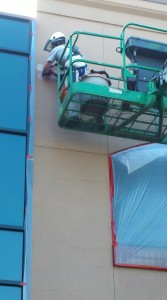 The contractor had a grinder with a shroud and vacuum to remove the dust. This would not be considered a worse-case sampling scenario. From conversations with the plasterer-employees onsite, grinding is usually “VERY dusty”.
The contractor had a grinder with a shroud and vacuum to remove the dust. This would not be considered a worse-case sampling scenario. From conversations with the plasterer-employees onsite, grinding is usually “VERY dusty”.
Sampling performed only for the duration of the grinding (3 hours). Conclusion?: We did not find any detectable levels of silica or respirable dust.
Please don’t use this sampling as the only information on how to proceed for your project. However, here are my observations:
- If acrylic material is the top 1/4 inch, you may not impact silica (or have any airborne).
- Airborne dust was very well controlled by grinder with shroud & vacuum (see pic below).
- Assume you will have dust until you can observe (or prove) otherwise. Wear a respirator.
- Perception is huge. If there is a big dust cloud coming from your grinder—even if there’s no silica… the observers don’t know the difference, and, well,…you know the story.
 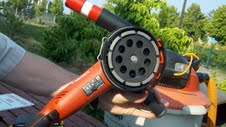
Wed 25 Apr 2012
This blog-post is directed to employees….the drywall framers, hangers, tapers, fireproofers & plasteres who sand and finish mud & drywall.
Question: What type of respirator do you wear when you sand?
…answer? Anything I can find.
This question misleading… and is similar to the one where the attorney asks in divorce court, “Do you beat your wife only when you’re drunk, or all the time?”
But, reiterate.  Do you ever NOT wear a respirator when sanding? Answer: No. We always wear a respirator. It’s dusty.
So if I may ask a leading question (as a bad attorney): What type of respirator would you wear if you were worried about OVERexposure?
Answer: a tight fitting 1/2 face (or full face, for eye protection & fogging control) negative pressure respirator with HEPA cartridges.
I think I’ve made my point. Why would you choose a paper dust mask? The fit is mediocre, they are disposable, you cannot fit test them (very well). Who cares if it’s a N95 or P100. You can feel the dust escaping around your nose. Below are some “average” pictures of people sanding. What will you do?  more info here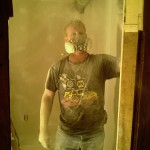

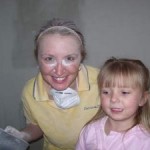
Tags: drywall, dust, fit test, framer, hanger, HEPA, IOM, mud, n95, p100, plaster, PPE, respirator, sand, sanding, tape, taper, tight fitting
Tue 20 Mar 2012
Posted by admin under confined space, Federal OSHA, Management, Permit Required
Comments Off on Confined space in construction
If you weren’t aware, OSHA is in the process  of establishing a ‘new’ rule (could be years) for confined spaces in construction (here).
In the meantime, if you plan on entering a space that is confined, below is my “standard” answer: Get help!
What I mean by this is; obtain some assistance as early as you can. Ideally this might even be before you bid the job. I often suggest to  send a superintendent or project manager to a 1/2 day training. Do not rely on the owner, or your general contractor to “safely approve” your employees entering this space. It is your job!
Although confined spaces are simple by definition (restricted opening, large enough to be in, and not meant to be occupied) , they can get  complicated easily. The first thing to consider is what is/was in the space. Secondly, what are you bringing into it? If those two questions are answered completely, the dangers are usually identified.
When reviewing, consider: electrical, oxygen, engulfment, entrapment, access (ingress & egress), coatings, noise, slips, temperature and emergency response (this is NOT an exhaustive list).
There are many other items and steps to have a well-run confined space program. Take a class, know the space, and train your employees. There are many resources at Federal OSHA and at your state OSHA, like Washington here, or like this one from Oregon.
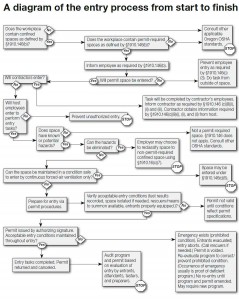
Tue 21 Feb 2012
There is much confusion over the requirements and best practices of employees using respirators voluntarily.
Let me first clarify.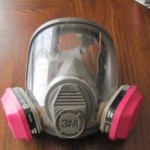 You must do air monitoring (or have other verifiable information) that employees are not REQUIRED to wear respirators (if they are overexposed to something, you must protect them). Also, they cannot voluntarily wear a respirators if there is a known hazard above the exposure limit (the employee cannot opt-out of wearing a respirator and be overexposed).
You must do air monitoring (or have other verifiable information) that employees are not REQUIRED to wear respirators (if they are overexposed to something, you must protect them). Also, they cannot voluntarily wear a respirators if there is a known hazard above the exposure limit (the employee cannot opt-out of wearing a respirator and be overexposed).
Some points about voluntary use:
- Assuming the above statement (s) is true, firstly, you do not have to allow them to wear respirators. I am sure this is arguable from a human resources/PR/legal stance. However, if you have documented no overexposure and have not provided a respirator, they should not need to wear one.
- Next, the employees need to be educated and you need to prove it. Having them sign Appendix D of the OSHA respiratory rule is a minimum. Training them would be better.
- What respirator are they wearing? A paper dust mask (N95, P100, or similar) is a respirator. If they are wearing anything other than this type of mask they need a medical evaluation (Appendix C of respiratory standard).
- If they are wearing a 1/2 face tight fitting negative pressure respirators (or more protective ones) the company needs to have a written respiratory program.
- Fit testing is not required to be performed
- Maintenance, inspection, storage, and training should always be done. Can you verify that the employee does this?
 I personally do not recommend the paper dust masks (N95, or similar) for this simple reason. Why would you wear this type of respirator if you could have a 1/2 face, tight fitting one with the correct cartridge? The cost difference is negligible, the protection is better, and you can be assured of a better fit. If you’re going to do it, do it right.
I personally do not recommend the paper dust masks (N95, or similar) for this simple reason. Why would you wear this type of respirator if you could have a 1/2 face, tight fitting one with the correct cartridge? The cost difference is negligible, the protection is better, and you can be assured of a better fit. If you’re going to do it, do it right.








